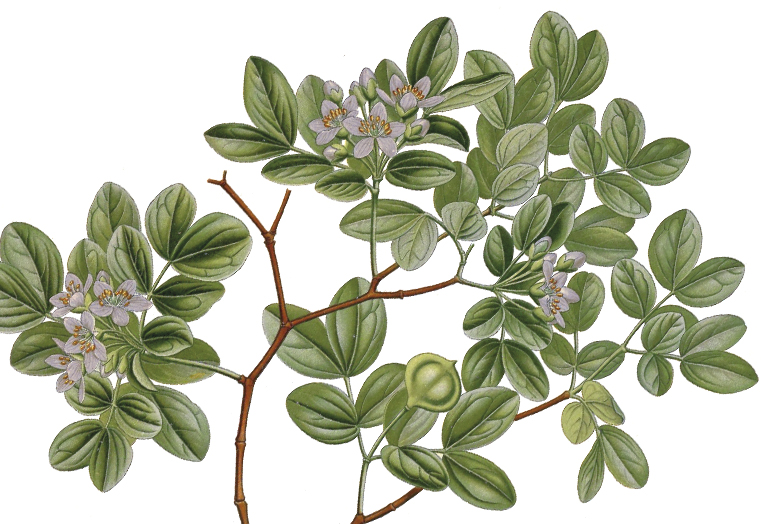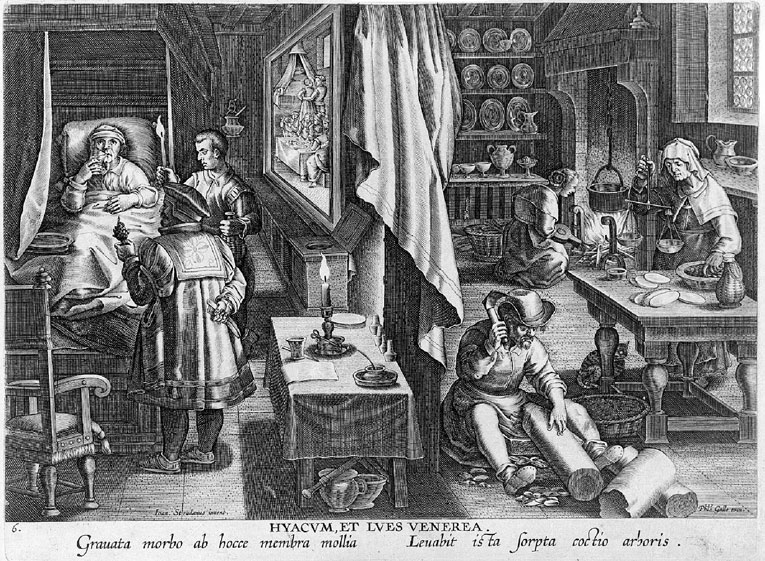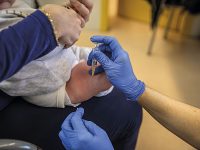
They named it guaiacwood. And Lignum vitae. No other medicine coming from the New World achieved such a great reputation during the first half of the sixteenth century in Europe. Guaiacwood logs would hang even from church roofs. Those sick with the «Great Pox» would kneel before them believing that their prayers would free them from the disease. It was the only hope to those who could not afford this expensive treatment: a pound used to cost around seven Spanish gold escudos. Syphilis had fallen upon the continent like a curse and an enormous business had boomed based on possible cures. Consequently, few goods generated such profit at the beginnings of the transatlantic trade, even though very few of them would turn out to be so useless. Today we know that those privileged who used the wood from this tree following the prescriptions of the best physicians of the era had the same chances to be cured than the poor people who had prayers as their only resource. Truth is, guaiacwood is completely ineffective against the Treponema pallidum bacteria. But then, how did it manage to become so famous? Apparently, particular interests played a big part on it. It is very possible that we are facing a scam, the first big medical fraud of the modern era. Let us go through it again.
The syphilis
«Great Pox» first hit on 1495. During the siege of Naples, where Aragonese and French troops fought, a great epidemic broke out and knocked out a good amount of soldiers, who suffered from pustules and sores that would even lead to their deaths. It would not be long until it spread throughout the continent. Once the campaign was over, mercenaries coming from all over Europe who had participated in it went back to their homes carrying the disease. The other name for this evil found its origin here: morbo gallico. To be fair, though, each one put the blame on their respective rival: Italians called it the «French disease» or the «Spanish disease», while the French referred to it as «Neapolitan disease». The Japanese named it the «Chinese pox», the Tahitians deemed to be «British», and the Turkish, «Christian».
Locating the origins of syphilis presents a greater difficulty: today it is still being discussed. Several skeletal remains prove that it existed on the pre-Columbian America, although it probably the disease was not transmitted sexually. There is also evidence of its presence in Europe prior to 1492, even though it is not conclusive. This apparent contradiction has fed a long controversy between those who place the origin of the disease in one continent and those who place it in another. The most accepted theory nowadays meets both assumptions halfway: according to it, the Columbian expedition would have carried Treponema trunks on its first trip back from America and these might have experienced some kind of mutation, which lead to the venereal disease that we know today.
In any case, there is no doubt about the magnitude of the outbreak in Naples. It has been estimated that between 5% and 20% of the European population might have suffered from syphilis during the first decades of the sixteenth century. Also quite evident is the social impact brought by the epidemic, considered at the time a divine test or punishment. Therefore, it isn’t strange that many physicians of the era paid great attention to it, and tried to find in the pharmacopoeia remedies that would alleviate the feared effects. Many of them opted for mercury, traditionally used in ointments aimed at treating leprosy and several skin problems. However, an excessive use of this toxic metal causes very damaging secondary effects that might go from losing teeth to experiencing tremors and paralysis, which is why many of the sick would rather endure the pains of the disease than to try this dangerous remedy. And so, it was the perfect breeding ground for the irruption of a new product that could promise a cure without any frightening drawbacks. Naturally, it didn’t take too long until it appeared.
GUAIACWOOD
The is no record of the first guaiacwood shipment to Spain, but according to several sources from the era, the wood of this tree native to tropical America was already being used on the Iberian Peninsula during the first decade of the sixteenth century. This novelty drew the attention of cardinal Matthäus Lang, counsellor of the Emperor Maximilian I, who organised an imperial commission that travelled around our country between 1516 to 1517 to analyse its application against the «Great Pox». The final report of this expedition would not see the light until 1535, even if the information obtained must have had been known for a good while. This would explain the immediate success of De guaiaci medicina et morbo gallico, work of the German humanist Ulrich von Hutten, which would be published also in German, French, English and Latin.
In this text from 1519 that praised the virtues of Lignum vitae against morbo gallico, Hutten goes through what it must have been the guaiacwood-based treatment at the time. The treatment would start with the preparation of an infusion consisting of one pound of chopped pieces of the trunk for eight pounds of water, which should be left to simmer until it reduced half its volume. Afterwards, the solution was given to the patient during a month, who would also have to endure a strict regimen that included remaining isolated in a high temperature room and eating as little as possible. The purpose of this was for the patient to sweat the illness out, following the precepts of humorism that prevailed at the time. But the sweating effects of guaiacwood do not work against the bacteria that causes syphilis. In fact, Hutten himself would die on 1523 victim of the same disease he thought he had defeated.
No one acknowledged this paradox and the publication of new books and pamphlets praising the virtues of the guaiacwood carried on during the following years. Among these, the Sumario de la Natural y General Historia de las Indias (1526), by Gonzalo Fernández de Viedo, a Castillian chronicler, stands out. He is the first to locate the origin of the syphilis in America. This gave the advocates of this remedy a new argument: at the time it was commonly believed that, in order to relieve humanity from its sorrows, God put disease and cure close by. This idea would also influence the poem Syphillis, sive morbus gallicus, written by the Italian physician Girolamo Fracastoro on 1530, who would allegorically attribute the disease to a shepherd named Syphilo. This gave the final name to the this new evil.
Nowadays, the great reputation achieved by this ineffective remedy seems strange. There are three main causes that may explain this phenomenon. We already discussed the first one: the sudden rising of syphilis and the terrible side-effects caused by the predominant treatment with mercury. At least, guaiacwood was harmless for the patient. We find the second one in the natural evolution of the disease, which alternates active and latent periods. The first symptoms of the infection –the apparition of chancres in genitals– disappear spontaneously after some weeks. The secondary phase starts about four months later when several skin lesions appear but they eventually heal as well. The late stage of syphilis, known as tertiary syphilis, is the truly dangerous one: the disease attacks the nervous system and causes irreparable neurological damage. However, this stage only develops after a long period of latency that might last decades. However, this symptomatology would be discovered throughout the sixteenth century and it comes as insufficient to explain the situation. The only way to explain the guaiacwood case is a third possibility: the advertising campaign led by the Fugger family to promote its use.

The treatment would start with the preparation of an infusion consisting of guaiacwood bits and water. The patient had to drink it regularly for a month. Patients also had to endure a strict regimen that included remaining isolated in a high temperature room and eating as little as possible. The purpose of this was for the patient to sweat the illness out, following the precepts of humorism that preveiled at the time. On the picture, an engraving by the Belgian painter Jan van der Straet representing different phases of the guaiacwood-based treatment. / Mètode
THE FUGGER FAMILY
This Augsburg-born family, the greatest bankers of their time, possessed an enormous financial empire in the beginnings of the modern era. They held wildly different interests such as raw materials trade, mining and spices. They also financed the prodigal Emperor Maximilian I, who would pass down all his domains as well as his debts to his grandson Charles. This was also a powerful reason to ensure he would inherit the Holy Roman Empire too. Because of this, the Fuggers loaned him a sizeable sum so he could bribe the prince-electors: 544,000 florins, two thirds of the amount collected to buy off allegiances. Once proclaimed, the now Charles I of Spain and V of the Holy Roman Empire would return this amount and then some through several lucrative concessions. This situation encouraged part of the family to move to Spain. There they would be known as Fúcares. They left some traces behind, such as a street in Madrid where they had a country house, or the use of their name as a synonym of a wealthy person.
Among the many businesses that Charles granted to the German family, there was the monopoly of the guaiacwood trade, the exploitation of which promised enormous benefits. Syphilis was all over Europe and it did not pay attention to social classes: there were many wealthy patients who were also in need of that promising American remedy. The Fuggers took advantage of this situation and initiated a very questionable campaign, which included paying physicians to promote this new panacea. Hutten himself admitted to this: he said that many physicians initially against the use of guaiacwood changed their minds after the proper reward. This dishonest practice would be denounced by Paracelsus. However, the Swiss physician did not enjoy during his lifetime the social recognition he gained afterwards; at the moment, his accusations found no support.
This was not the only initiative carried on by the Fuggers to promote their product. One that has made it to present days is the holzhaus, a German term translatable as “trunk house”. This sort of hospital, which is still open to visitors in the neighborhood in Augsburg founded by the banker family, the Fuggerei, tended to syphilis patients and set an example to other similar establishments that opened in several European cities.
Thanks to all these incentives, for several decades the guaiacwood was one of the few goods coming from the New World worth enough to load entire ships. The high demand kept the wheels of the business well-oiled. The route started in La Hispaniola, made a stop in Sevilla, and ended in any random European city. A long journey that gave room to many deceptions, such as disguising any possible damage that the trunks might have suffered on their way with clay, or mixing guaiacwood shavings with cheaper wood when possible. This grotesque fraud would not last forever, of course. Gradually, the null effectiveness of the guaiacwood became obvious and many voices arose questioning it. And so, the not-so-long-ago miraculous remedy began losing its reputation and even scholars who had fostered its use, such as Girolamo Fracastoro, would speak badly of it. By the end of the sixteenth century, this craze had practically ended and the prosperous business had disappeared.
Nowadays, we may wonder about the reason behind this phenomenon, how the interest for the guaiacwood first arised and then spread so extensively thanks to the hopes of thousands of sick people and the commercial motivation of the Fuggers. Several authors of the time wrote about its origins, although they could only do it from what they had heard, since they lived in Europe. Not even the aforementioned Sumario from Fernández de Oviedo, who spent a long period of his life in America from 1514 onwards, could be considered a first-hand source: several texts set the arrival of guaiacwood to the Iberian Peninsula in the previous decade. Neither the ancient Aztec codices nor the current ones from Mexican herbalists provide any answers: they do not mention a medicinal use of this kind of wood. Maybe this use was restricted to the Caribbean islands and the fast collapse of the taíno culture has deprived us of the explanation we are looking for. We can only speculate about a confusing meeting in La Hispaniola between indigenous people and conquerers. The second ones probably understood either what they wanted or what they needed to understand.
We might also wonder why other remedies as useless did not lose their prestige. For instance, mercury, which stayed as the prevailing medicine against syphilis until the arrival of the twentieth century. It would not be until the work of the German physician Paul Ehrlich, which culminated in the revolutionary discovery of the synthetic drug Salvarsan, that the fatal omen «one night with Venus, a lifetime with Mercury» became a simple memory.
REFERENCES
Esteva de Sagrera, J. (2004). Historia de la farmacia: Los medicamentos, la riqueza y el bienestar. Barcelona: Elsevier Masson.
Fernández de Oviedo, G. (1526). Sumario de la Natural y General Historia de las Indias. Retrieved from http://historia.ucr.ac.cr/cmelendez/bitstream/123456789/573/1/SumarioNaturalHistoriaIndias.pdf
Fresquet, J. L. (2005). La sífilis. Eidon, 17, 52–57. Retrieved from http://www.revistaeidon.es/numeros_anteriores/eidon_17.pdf
Harper, K. N., Zuckerman, M. K., & Armelagos, G. J. (2014). Syphilis: Then and now. The Scientist Magazine. Retrieved from http://www.the-scientist.com/?articles.view/articleNo/38985/title/Syphilis–Then-and-Now/
Mejía, P. (2014). Banqueros alemanes en la España de Carlos V. Boletín de la Sociedad Geográfica Española, 48, 46–61. Retrieved from http://www.sge.org/sociedad-geografica-espanola/publicaciones/boletines/numeros-publicados/boletin-no-48/banqueros-alemanes-en-la-espana-de-carlos-v.html
Munger, R. S. (1949). Guaiacum, the holy wood from the New World. Journal of the History of Medicine and Allied Sciences, IV(2), 196–229. doi: 10.1093/jhmas/IV.2.196
Parascandola, J. (2009). From mercury to miracle drugs: Syphilis Therapy over the centuries. Pharmacy in History, 51(1), 14–23. Retrieved from http://www.jstor.org/stable/41112412
Pardo, J. (2002). El tesoro natural de América. Colonialismo y ciencia del siglo xvi. Madrid: Nivola libros y ediciones.
Pardo, J., & López, M. L. (1993). Las primeras noticias sobre plantas americanas en las relaciones de viajes y crónicas de Indias (1493-1553). València: Instituto de Estudios Documentales e Históricos sobre la Ciencia. Retrieved from http://hdl.handle.net/10261/91333
REFERÈNCIES
Esteva de Sagrera, J. (2004). Historia de la farmacia: Los medicamentos, la riqueza y el bienestar. Barcelona: Elsevier Masson.
Fernández de Oviedo, G. (1526). Sumario de la Natural y General Historia de las Indias. Consultat en http://historia.ucr.ac.cr/cmelendez/bitstream/123456789/573/1/SumarioNaturalHistoriaIndias.pdf
Fresquet, J. L. (2005). La sífilis. Eidon, 17, 52–57. Consultat en http://www.revistaeidon.es/numeros_anteriores/eidon_17.pdf
Harper, K. N., Zuckerman, M. K., & Armelagos, G. J. (2014). Syphilis: Then and now. The Scientist Magazine. Consultat en http://www.the-scientist.com/?articles.view/articleNo/38985/title/Syphilis--Then-and-Now/
Mejía, P. (2014). Banqueros alemanes en la España de Carlos V. Boletín de la Sociedad Geográfica Española, 48, 46–61. Consultat en http://www.sge.org/sociedad-geografica-espanola/publicaciones/boletines/numeros-publicados/boletin-no-48/banqueros-alemanes-en-la-espana-de-carlos-v.html
Munger, R. S. (1949). Guaiacum, the holy wood from the New World. Journal of the History of Medicine and Allied Sciences, IV(2), 196–229. doi: 10.1093/jhmas/IV.2.196
Parascandola, J. (2009). From mercury to miracle drugs: Syphilis Therapy over the centuries. Pharmacy in History, 51(1), 14–23. Consultat en http://www.jstor.org/stable/41112412
Pardo, J. (2002). El tesoro natural de América. Colonialismo y ciencia del siglo xvi. Madrid: Nivola libros y ediciones.
Pardo, J., & López, M. L. (1993). Las primeras noticias sobre plantas americanas en las relaciones de viajes y crónicas de Indias (1493-1553). València: Instituto de Estudios Documentales e Históricos sobre la Ciencia. Consultat en http://hdl.handle.net/10261/91333





